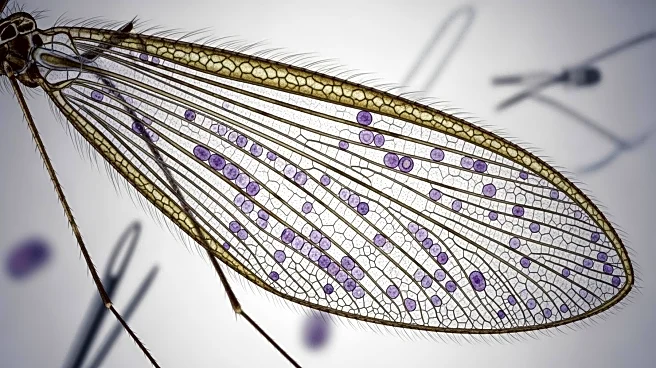What's Happening?
A research team has created the first-ever cellular atlas of the Aedes aegypti mosquito, a species known for transmitting numerous diseases. This comprehensive atlas provides a detailed view of gene expression across various mosquito tissues, including
both male and female specimens. The study, published in the journal Cell, utilized single-nucleus RNA sequencing to analyze over 367,000 nuclei from 19 different tissue types. This effort revealed 69 cell types grouped into 14 major categories, many of which were previously unidentified. The research highlights significant differences and unexpected similarities between male and female mosquitoes, particularly in sensory neuron organization and gene expression changes following blood feeding.
Why It's Important?
The creation of this cellular atlas is a significant advancement in understanding the biology of the Aedes aegypti mosquito, which is crucial for developing more effective disease control strategies. By providing insights into the genetic and cellular makeup of both male and female mosquitoes, the atlas can aid in identifying new targets for controlling mosquito populations and reducing the spread of diseases such as dengue, Zika, and chikungunya. The detailed understanding of gene expression changes, especially in female mosquitoes post-blood feeding, could lead to innovative approaches to disrupt the mosquito's lifecycle and reduce its capacity to transmit diseases.
What's Next?
The dataset from this research is freely available to the global scientific community, encouraging further studies and discoveries. Researchers can use this resource to explore new methods for mosquito control and to develop targeted interventions. The findings may prompt additional research into the specific functions of newly identified cell types and the genetic mechanisms underlying mosquito behavior and reproduction. Continued exploration of these areas could lead to breakthroughs in vector control and public health strategies.
Beyond the Headlines
This research not only advances scientific understanding but also highlights the importance of inclusive studies that consider both male and female specimens. Historically, research has focused predominantly on female mosquitoes due to their role in disease transmission. By including male mosquitoes, this study provides a more comprehensive view of the species' biology, which could have implications for broader ecological and evolutionary studies.













